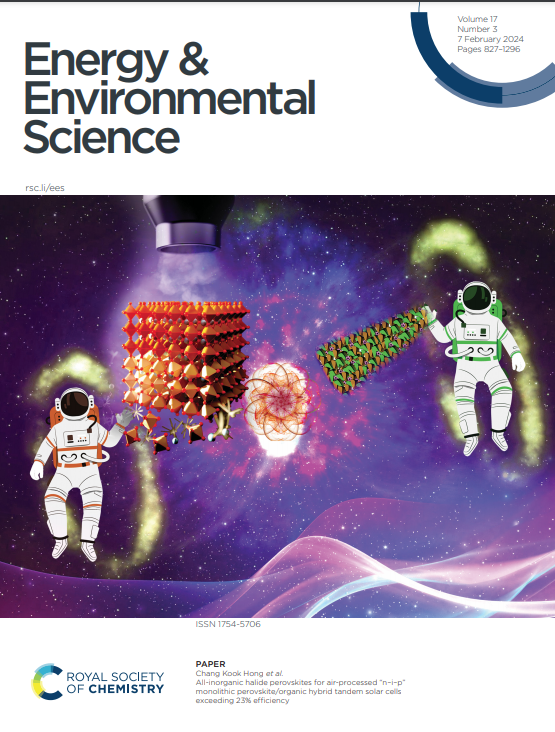氟化碳氮化物辅助溶剂调节工程,用于长寿命固态锂电池的聚偏氟乙烯基电解质
IF 30.8
1区 材料科学
Q1 CHEMISTRY, MULTIDISCIPLINARY
引用次数: 0
摘要
聚偏氟乙烯(PVDF)基电解质具有广阔的潜在窗口和可靠的机械强度,在固态锂电池(sslb)中具有巨大的应用潜力。然而,与高反应性残留溶剂相关的关键界面问题使电解质的稳定性在长期循环中迅速恶化。本文提出了一种溶剂调节工程,通过引入具有不同电子结构的二维氟化C3N5 (F-C3N5)来抑制残留溶剂。F-C3N5的强吸附作用有助于选择性捕获残留溶剂,从而通过减弱Li+与溶剂的结合强度,使更多阴离子参与溶剂化。富阴离子溶剂化结构和F-C3N5填料都参与了无机主导的阴极电解质界面层(CEI)和固体电解质界面层(SEI)的形成,从而抑制了在电极/电解质界面发生的不良寄生反应。因此,F-C3N5与pvdf基电解质的集成使锂对称电池具有2.3 mA cm−2的高临界电流密度,以及0.5 mA cm−2下800 h的稳定镀/剥离循环。相应的LiNi0.6Co0.2Mn0.2O2/Li电池在1C下循环300次后的容量保持率为86.4%。这项工作为使用功能化的F-C3N5来定制溶剂化结构以稳定pvdf基电解质提供了一个新的视角。本文章由计算机程序翻译,如有差异,请以英文原文为准。
Fluorinated carbon nitrides assisted solvation-regulation engineering toward polyvinylidene fluoride-based electrolytes for long-lifespan solid-state lithium batteries
Polyvinylidene fluoride (PVDF)-based electrolytes show huge potential in applications of solid-state lithium batteries (SSLBs) due to their broad potential windows and reliable mechanical strengths. However, the critical interfacial issues associated with high-reactivity residual solvents enable rapidly deteriorative stability of electrolytes toward long-term cycling. Herein, a solvation-regulation engineering is proposed by introducing two-dimensional fluorinated C3N5 (F-C3N5) with distinct electronic structure for restraining residual solvents. The strong adsorption effect of F-C3N5 contributes to selective capture of residual solvent, thereby enabling more anions being participated in solvation by weakening binding strength between Li+ and solvent. Both anion-rich solvation structures and F-C3N5 fillers are involved in forming inorganic-dominated cathode electrolyte interphase (CEI) and solid electrolyte interphase (SEI) layers, which inhibit undesirable parasitic reactions occurred at electrode/electrolyte interfaces. Consequently, the integration of F-C3N5 with PVDF-based electrolyte endows Li symmetric cell with a high critical current density of 2.3 mA cm−2, and a stable Li plating/stripping cycling of 800 h at 0.5 mA cm−2. The corresponding LiNi0.6Co0.2Mn0.2O2/Li cell delivers an excellent capacity retention of 86.4% after 300 cycles at 1C. This work provides a novel perspective of using functionalized F-C3N5 to tailor solvation structures for stabilization of PVDF-based electrolytes.
求助全文
通过发布文献求助,成功后即可免费获取论文全文。
去求助
来源期刊

Energy & Environmental Science
化学-工程:化工
CiteScore
50.50
自引率
2.20%
发文量
349
审稿时长
2.2 months
期刊介绍:
Energy & Environmental Science, a peer-reviewed scientific journal, publishes original research and review articles covering interdisciplinary topics in the (bio)chemical and (bio)physical sciences, as well as chemical engineering disciplines. Published monthly by the Royal Society of Chemistry (RSC), a not-for-profit publisher, Energy & Environmental Science is recognized as a leading journal. It boasts an impressive impact factor of 8.500 as of 2009, ranking 8th among 140 journals in the category "Chemistry, Multidisciplinary," second among 71 journals in "Energy & Fuels," second among 128 journals in "Engineering, Chemical," and first among 181 scientific journals in "Environmental Sciences."
Energy & Environmental Science publishes various types of articles, including Research Papers (original scientific work), Review Articles, Perspectives, and Minireviews (feature review-type articles of broad interest), Communications (original scientific work of an urgent nature), Opinions (personal, often speculative viewpoints or hypotheses on current topics), and Analysis Articles (in-depth examination of energy-related issues).
 求助内容:
求助内容: 应助结果提醒方式:
应助结果提醒方式:


